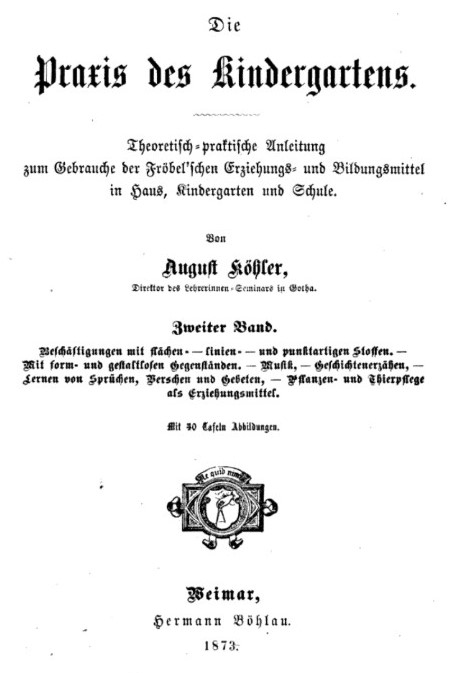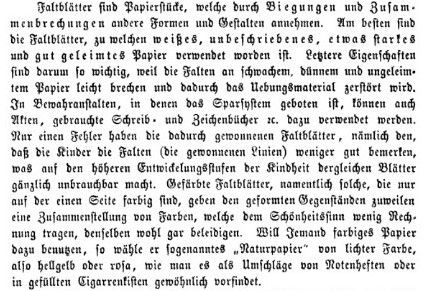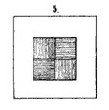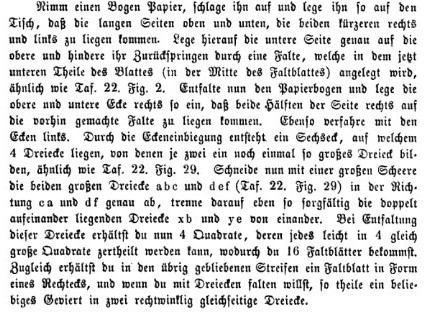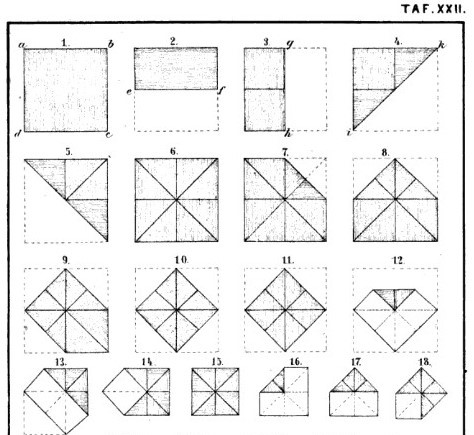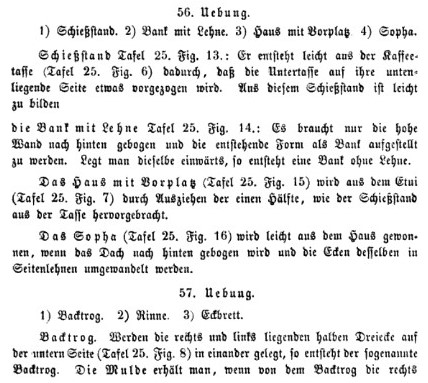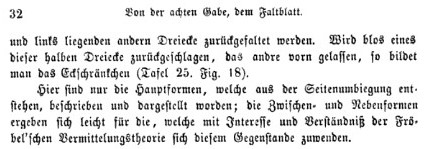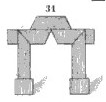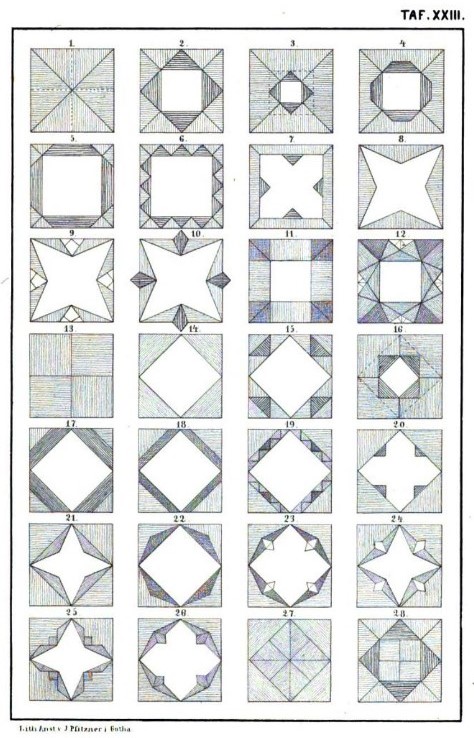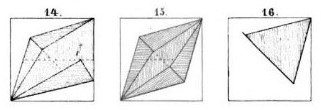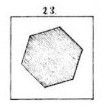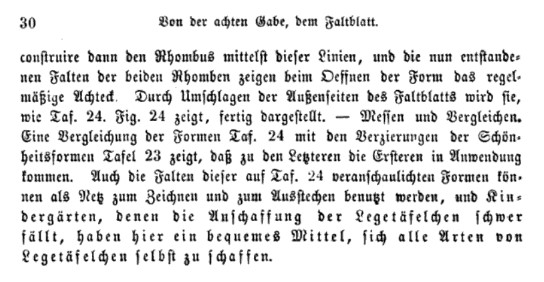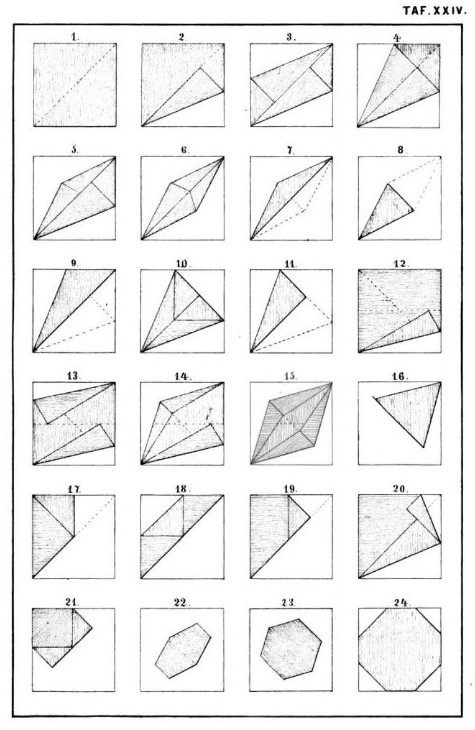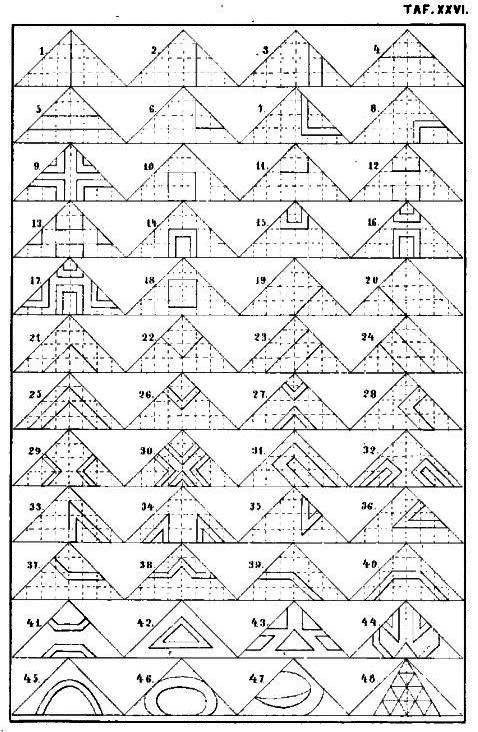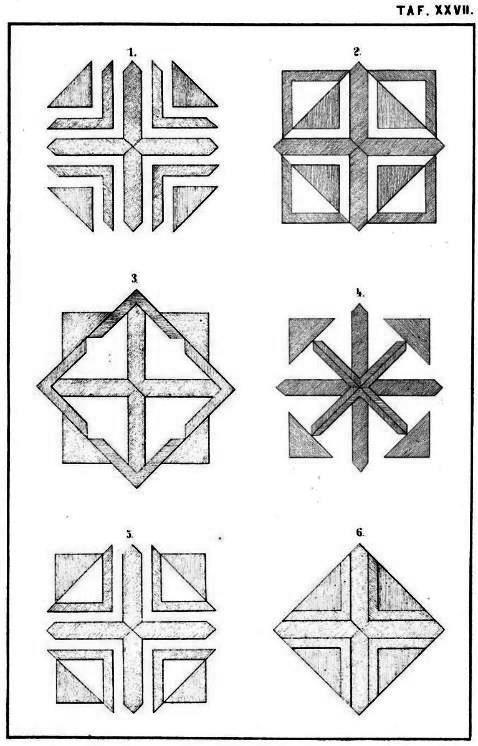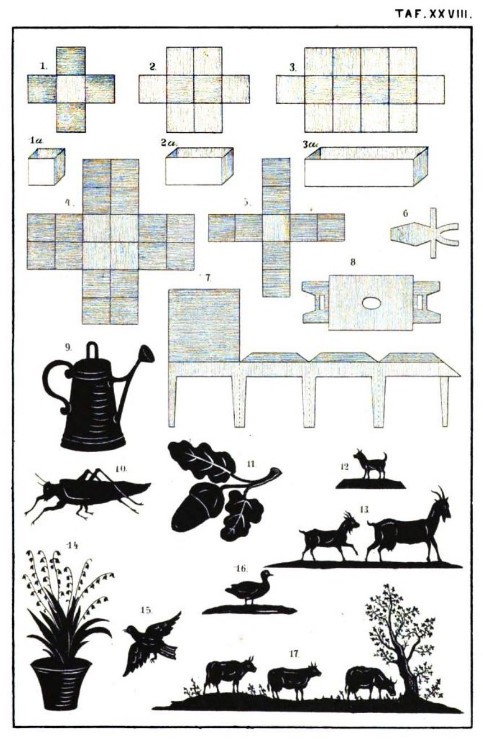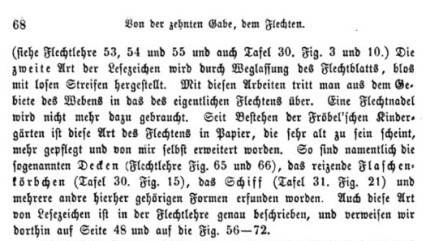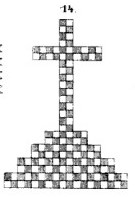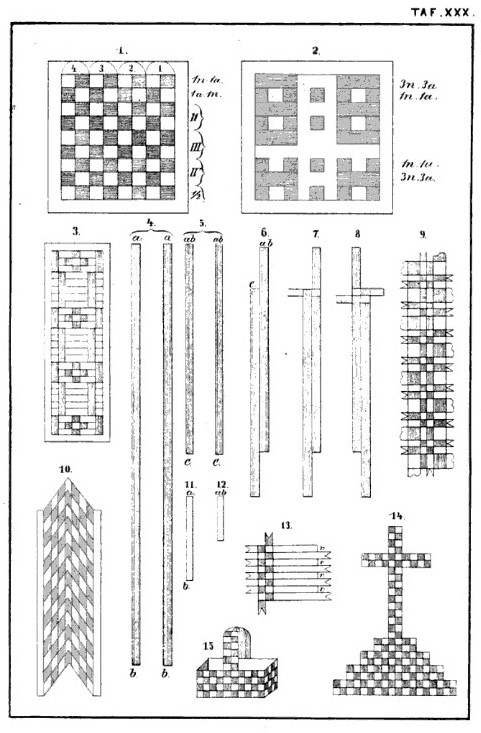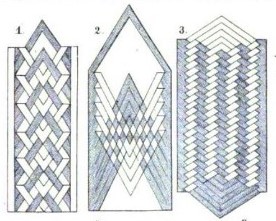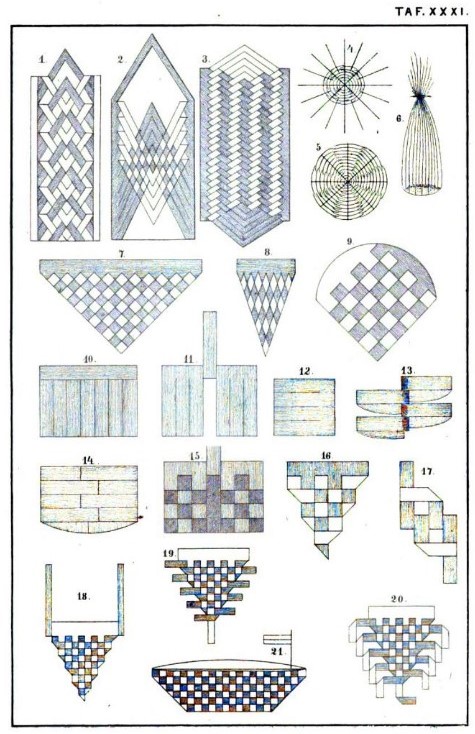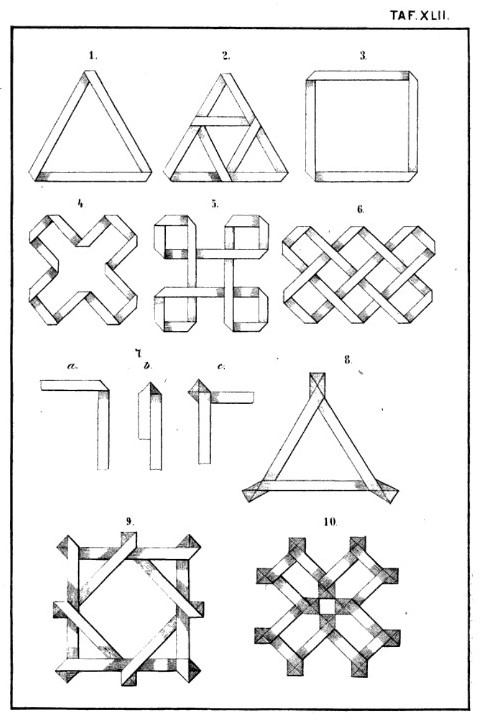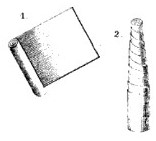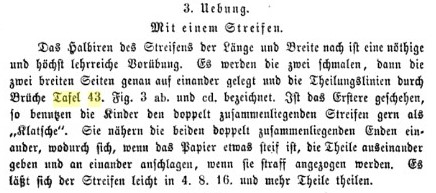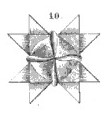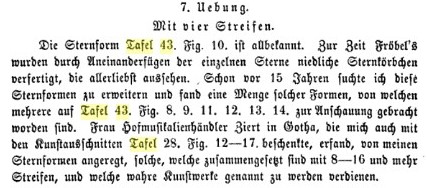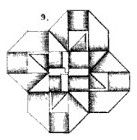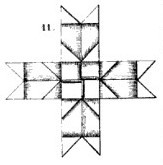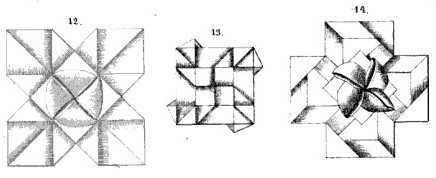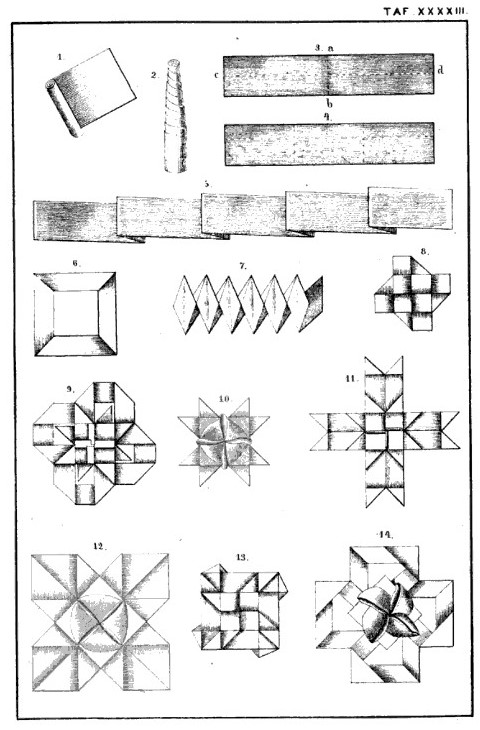| The Public Paperfolding History Project
Last updated 25/9/2025 x |
|||||||
| Die Praxis Des Kindergartens, Part 2, by August Koehler, 1873 | |||||||
| 'Die
Praxis Des Kindergartens' by August Koehler was published
in three parts by Herman Bohlau in Weimar. Inter alia,
Part 2, which was published in 1873, contains information
about: The 8th Gift - Dem Faltblatt (ie Falten) The 9th Gift - Dem Ab- und Auschneideblatt (ie Ausschneiden und Aufkleben) The 10th Gift - Dem Flechten (Weaving) The 15th Gift - Den Schnurstreifen (Strips) The numbering scheme assigned to the gifts is the authors own and is not the same as that used by Froebel. A full copy of the work can be accessed here. All the forms explained in this work which are developed from Koehler's Groundform are almost certainly original designs by the author, and this is also most probably true of the designs developed from the 2x1 rectangle and the triangle. The author also claims that some of the Free Weaving designs, specifically the Woven basket and the Woven Ship are his own designs, and that he has also invented some of the braided designs shown on Plate XXXI and the Paper Rosette variations shown on Plate XXXIII. **********
********** Analysis The 8th Gift - Dem Faltblatt (The Folding Sheet) (ie Falten) Introductory Material About suitable types of paper The author recommends the use of 'white, unwritten, somewhat stiff and well-sized paper' ... 'where economy is necessary.used writing and drawing books can also be used ... The sheets obtained in this way have one drawback, namely that children can see the folds less well, which makes such sheets unusable at the higher stages of childhood development. Coloured sheets, especially those coloured on only one side, sometimes give the shaped objects a combination of colours that pay little attention to the sense of beauty, and may even offend it ...'
********** Koehler's Groundform The text on page 12 states, roughly paraphrased, that: 'In Froebel's time kindergartens knew only one kind of folding sheet, the square, and only one method of developing it, by folding the corners inwards. In 1861*, the author introduced the rectangle and the triangle as folding sheets and showed how to fold the square in a second way, by folding the edges inwards. ... Folding is conceivable with all regularly shaped pieces of paper. Here, however, only the square, rectangle and triangle will be worked upon.' * 'Kindergarten and Elementarklasse. II Jahrang. Weimar. Bohlau 1861'. (I have not been able to trace a copy of this work.)
This new method of developing the square is shown in pictures 1 to 18 of Plate XXV below. I call the base shown in picture 5 Koehler's Groundform.
********** Froebel's Method of Cutting Four Squares from a Rectangle.
Koehler suggests subdividing each of Froebel's four squares into four to make sixteen smaller squares, and that these can be cut in half if you want to fold with triangles. ********** Folds of Life Simple Folds of Life Exercises 2 to 8 describe how to teach the basic folds, ending with Picture 19, which is the Triple Blintz Basic Form. In many of these exercises the author gives names to the various shapes, as if treating them as Simple Folds of Life, but the names vary between the exercises and many seem to bear little relationship to the form they are supposed to describe.
********** Forms derived from the Triple Blintz Basic Form Flacon (bottle) - The Scent Bottle
********** Jade mit furzen armeln - The Short Sleeved Jacket
********** Kreuz - The Cross
********** Tintenfass / The Inkwell
********** Setzwage / The Hat
********** Steifelchen / The Pair of Boots
********** Kinderjade / The Jacket
********** Kinderhose / The Trousers
********** Forms derived from the Windmill Windmuhle / The Windmill The Windmill is made from the Jacket by opening out the collar and waistband. The result is a Windmill folded from a blintzed square. All the other designs in this section are made from this form.
********** Tisch / The Table Described but not illustrated.
********** Cigareenetui / The Cigar Case
*********** Schiff / The Ship
********** Gegelboot / The Boat with Sail
********** Gegelboot / Boat with Sail variation
********** Doppelboot / The Double Boat
********** Rabe (crow) / The Cocotte / Pajarita
********** Ente / The Duck
********** Kralle / The Claw
********** The Inverted Claw
********** Kasten / The Junk Box
********** Spiegel / The Mirror
********** Festes flaches kastchen / The Solid Box
********** Gondel / The Chinese Junk
********** Forms developed from the Double Blintz Basic Form Salz und Pfeffersabchen / The Salt Cellar Mentioned but not described or illustrated ********** Lowenmaul (Snapdragon) - probably the Salt Cellar used as a snapper Mentioned but not described or illustrated ********* ? - probably The Travel Bag Mentioned but not described or illustrated ********* Kragen (collar) - The Collar
********** Forms developed from Koehler's Groundform Kaffeetasse / The Cup and Saucer
********** Schweinchen / The Pig
********** Schussweite / The Shooting Range
********** Bank mit Lehne / The Bench
********** Sopha / The Bench with Arms
********** Haus mit Borplas / House with Forecourt
********** Picture 17 is not mentioned in the text but appears to be Another Double Boat which is developed from Version 2 of the Cigar case.
********** The text also mentions two other designs called Badtrog (Bath Tub) and Rinne (Gutter). These forms are not pictured and I cannot reconstruct from the description.
********** Unknown / The Corner Cabinet
********** Forms developed from the rectangle The rectangle used for these Folds of Life is a 2x1 made by cutting a square in half. Schaufel / The Shovel
********** Bank / The Stand
********** Kasten / The Basic Box
********** Schone Thor / The Beautiful Gateway
********** Krippe (crib) / The Crib (Made by placing the Basic Box onto a more decorative version of the Stand)
********** Sopha / The Seat (Made by placing the base of the Crib on top of the Stand)
********** Forms developed from the triangle (Presumably the isosceles right angle triangle) Pantoffel / The Slipper
********** Schonnheitsforman - Folds of Beauty Pictures 1 and 13 show the two sides of the Double Blintz Basic Form from which patterns 2 to 12 and 14 to 26 can be derived. Pictures 27 and 28 show other groundforms from which the author says further Folds of Beauty can be developed. The groundform shown in picture 27 appears to me to be the Windmill Base (with the front flaps folded in half outwards).. The form shown in picture 28 appears to me to be the doubly blintzed square (made without turning over in between the two blintzing operations), again with the front flaps folded in half outwards. No illustrations of forms derived from these two groundforms are given.
********** Erkenntnisformen - Forms of Knowledge Plate XXIV also shows a series of geometrical / mathematical paperfolds made using 22.5/45/90 degree and 30/60/120 degree folding geometries.Apart from Picture 24, the regular octagon, all of these had previously appeared in the author's earlier work 'Der Frobel'sche Faltblatt.' Constructing an Equilateral Triangle Pictures 12 through 16 of Plate XXIV show a method of producing an equilateral triangle from a square.
********** Constructing a Regular Hexagon Picture 23 shows a regular hexagon which has been created by truncating the Diamond.
********** Constructing a Regular Octagon Picture 24 shows a regular octagon inscribed within a square. The folding instructions state that the 60/120 degree rhombus shown in Fig 15 is the basis of this figure, but this is an error. The basis is in fact the rhombus shown in Picture 6.
**********
********** The 9th Gift - Dem Abschneiden und Auschneideblatt (The Cutting Sheet) (ie Ausschneiden und Aufkleben) This sectiuon of the work begins with a simple set of exercises designed by the author to teach children how to make cuts in folded paper. Then in Plate XXVI the author first gives examples of patterns that can be cut from a square folded into an eight layer right angle isosceles triangle. Plate XXVII shows the result of mounting the pieces produced by some of these cuts onto another sheet of paper. Note that the pieces that are cut out of the square are not discarded but used as paret of the mounted design.
********** Cardboard Modelling Designs There is just one paragraph tagged on to this section which mentions designs made by the cardboard modelling technique.
********** The 10th Gift - Dem Flechten Free Weaving Designs The top paragraph on page 68 reads, roughly translated, 'The second type of bookmark is made by using only loose strips and omitting the weaving sheet. ... Since the establishment of the Froebel kindergartens, this kind of braiding in paper, which appears to be very old, has been more cultivated and expanded by myself. Thus in particular ... the charming basket (Plate XXX, Fig 16), the ship (Plate XXXI, Fig 21) and several other related shapes have been invented.'
The Woven Basket
********** The Woven Ship
********** The author does not say what the 'several other related shapes' are, but they would not include, for instance, The Woven Cross (which see).
**********
********** Fold and Cut Chevron Designs The second paragraph on page 68 reads, roughly translated, 'The third type (of bookmark) differs from the preceding ones in that only plaiting sheets, and no loose strips, are used for braiding. ''' Plate 31, Figs 1, 2, 3 etc. The plaiting sheets have slanted or horizontal cuts. Since the publication of Braiding instructions, several new forms of this typeof braiding have also been invented by the author, which deserve attention, and will be discussed below.'
**********
********** The 15th Gift - Den Schnurstreifen (The Strips) Verschnuren (Note that the author does not use this term) On page 109 the author explains, roughly translated, 'Strips are as long as possible, folded three times (along the length) ... which can easily be obtained from written or blank, white or coloured sheets of paper.'
The author also comments that, 'The use of this material to create shapes is not new, and the same applies to it as has been said of Froebel's other craft materials, namely, that they are not Froebel's invention.'
**********
********** Other designs rolled / folded from strips In this section the author explains various other designs made from paper strips, which seem to be viewed as preparatory exercises to paper strip interlacing proper. Paper curls The author says, roughl;y translated, 'The strip is rolled up like a long ribbon. This rolling up requires a peculiar manual dexterity which is highly educational for both hands to learn. Little girls are known to make curls for themselves and thir dolls by opening out such rolled up strips.'
********** Butterstampfe / The Butterchurn The text explains how in this action design a strip of paper is first rolled up and then the centre of the roll is pulled out and pushed back in to simulate the action of churning butter.
********** Klatsche / The Clapper The text says, roughly, 'The children like to use double folded strips as 'clappers'. They bring the two double-sided ends so that ... the pieces come together and hit each other.' It is not clear to me, however, how the noise is to be achieved.
********** Katzenstreppchen (cat staircase) / The Witch's Ladder The text says that this design is folded from two strips and so despite the strangeness of the illustration I believe it is the Witch's Ladder.
********** The Paper Rosette and Koehler's own variations
The text says that in Froebel's time the basic stars (shown in picture 10) were joined together to make 'cute star baskets'. The author states that, about 15 years ago, so in c1857/8, he discovered some variations. These are shown in pictures 8, 9, 11, 12, 13 and 14. The author also mentions that Frau Ziert invented further variations which 'deserve to be called true Artworks', but, as far as I can see, these designs are not pictured in the book.
**********
********** |
|||||||
